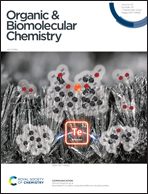Recent progress of direct thiocyanation reactions
Abstract
Thiocyanates are common in natural products, synthetic drugs and bioactive molecules. Many thiocyanate derivatives show excellent antibacterial, antiparasitic and anticancer activities. Thiocyanation can introduce SCN groups into parent molecules for constructing SCN-containing small organic molecules. Among them, the direct introduction method mainly includes nucleophilic reaction, electrophilic reaction and free radical reaction, which can simply and quickly introduce SCN groups at the target sites to construct thiocyanates, and has broad application prospects. In this review, we summarize the research progress of direct thiocyanation in recent years.



 Please wait while we load your content...
Please wait while we load your content...